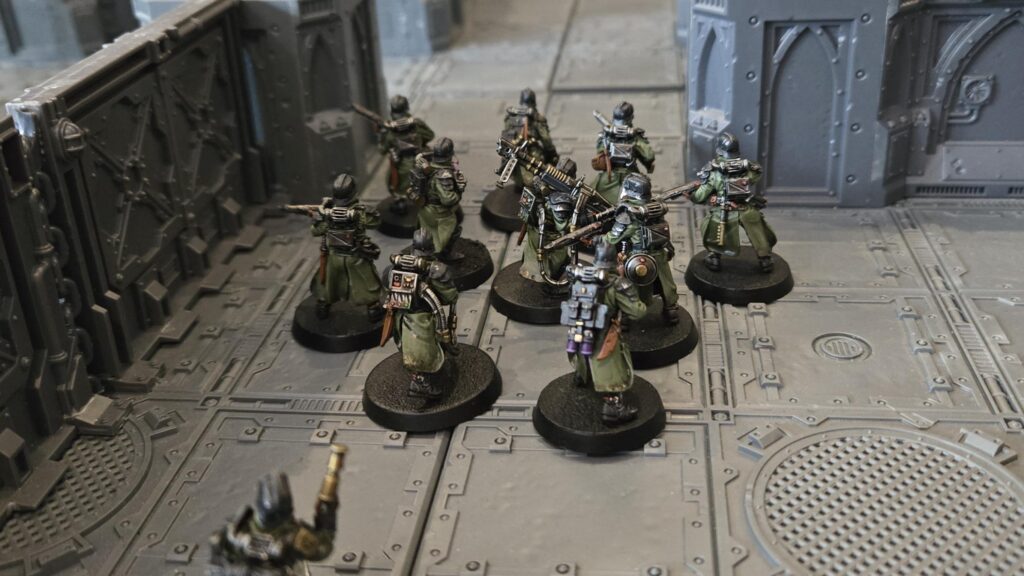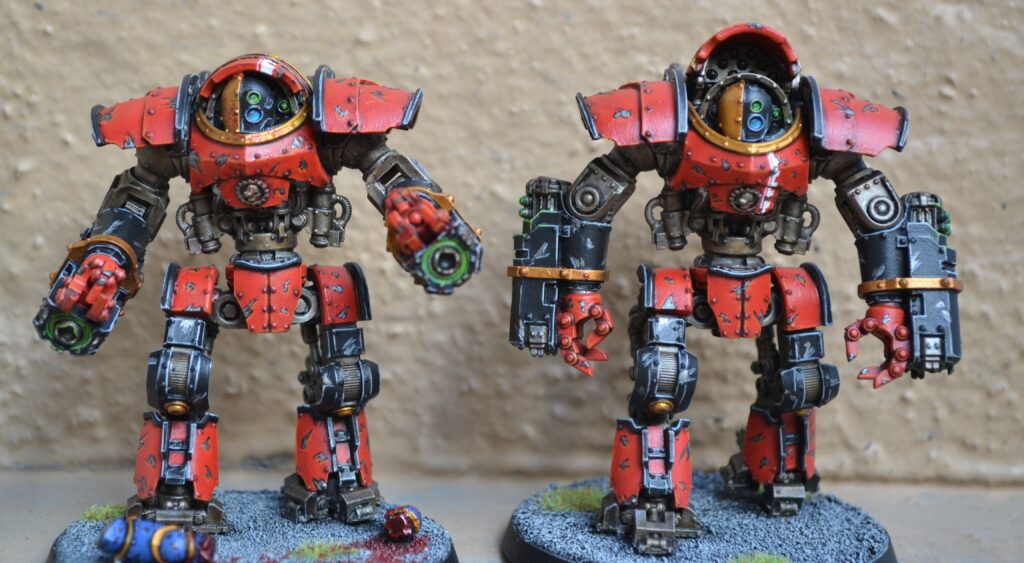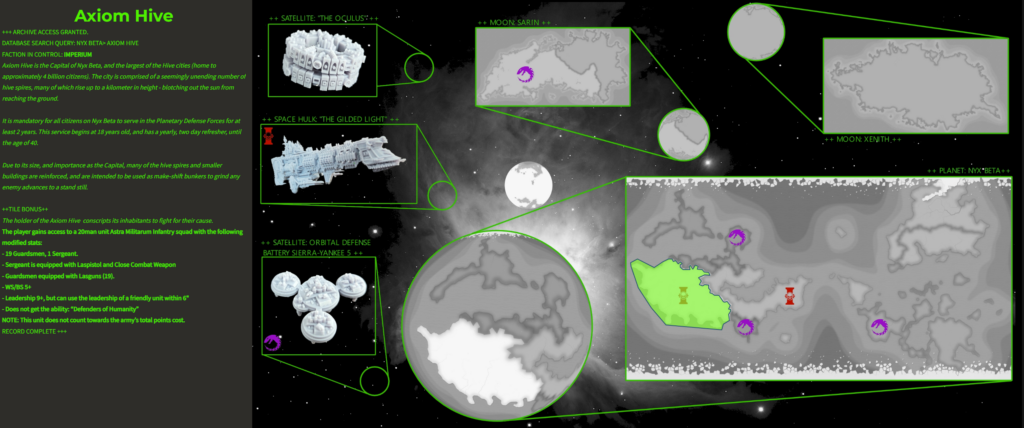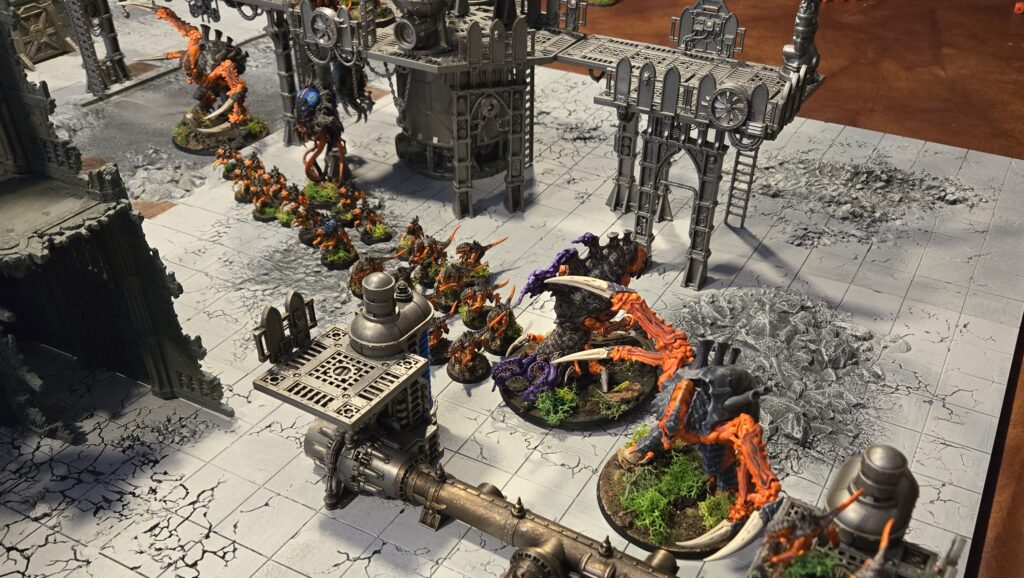The Devouring of Nyx-Beta - An Interview

Grenadier’s of the Death Korps 32nd Assault Korps Sweeping and Clearing an Unknown Facility
This past year, Jeff, our site’s Techpriest, ran a great 40k campaign that I had the pleasure of playing in! I managed to pull him away from the cogitators (and his painting desk) long enough to ask a few questions about running the campaign.
I: Have you ran a campaign before? Why did you decide to run this campaign and what was the inspiration?
J: Nope! Never have run one solely by myself before. However I have helped out with other campaigns our group had run, so it wasn’t completely new to me.
The idea to run the campaign started when 10th edition came out. Our local gaming group was pretty stoked for a new edition and into the idea of one. Plus, I wanted to have a reason to get more consistent games of 40k in (I typically play 30k).
I: You created the Tavian Cluster subsector in our group’s narrative setting. Can you talk about the backstory and lore for the setting and campaign?
J: So our group does all of our events within a sliver of the galaxy called the Pilgrim Sector. Over the years we’ve explored some various systems. When creating the campaign I didn’t want to reuse an existing location. Instead I wanted to create an area of space that I could make into my own sandbox, one that could have an easy explanation for any faction showing up. So with that said, the general lore for the subsector is:
The Taivian Belt is a wide-spanning, resource-rich subsector, where many have gone to try and make a name for themselves. The area is known for its vast number of manufactorums, shipyards, and forgeworlds. Being on the outskirts of the Pilgrim Sector, it is a primary hub for trade into, and out of the sector. However, being located on the outskirts makes it very vulnerable to attack from the Imperium’s many enemies.
From there, I created the introduction to the campaign. It was created after I knew what factions would be present. It worked out well because we had a Tyranid faction, and the old Second Tyrannic War occurred in a nearby sector. This provided a great backdrop for a new invading fleet elsewhere in the heart of the Imperium.
After the defeat of the Tyranids on Ichor IV during the second Tyrannic War (M41.993), the remaining hive fleet elements scattered north. For years they laid low, hiding from the gaze of the Imperium rebuilding their forces – consuming planets only when absolutely necessary, and with no conceivable pattern.
Fifty years to the day after the end of the Second Tyrannic War, an organic warp beacon was lit by a hidden sect of Genestealer Cultists on Nyx-Beta’s moon, Serin. This beacon was picked up by the surviving splinter fleets. With the full might of Hive Fleet Leviathan attacking within Segmentum Pacificus, pulling the Imperium’s focus, these splintered fleets decided now is the time to renew their harvest in full.
The last piece to it all was creating the Eskair system that the planet of Nyx Beta, the players would be fighting over. I created a planet card in the style of the old Forgeworld Imperial Armour books. And then created short blurbs for each location as inspiration struck. I won’t post them all here. But you can download the player pack with it all at: https://wrongsideofthemaelstrom.com/nyxbetamap/
I: Which factions did you want to include and why? Were there any factions you wish you could have included? Or any that caused problems?
J: I knew I wanted the campaign to be centered around an Imperial world. Mainly for selfish reasons of wanting to play my Death Korps… But other than that, I didn’t start the process with any specific invading factions in mind.
When planning, I first got a list of what factions everyone played (or was wanting to play). It turned out there was a pretty even split of Tyranids/Genestealer Cults* and various Imperium factions. So it just sort of worked out.
Having two factions that were naturally linked in the lore created a nice backdrop for the campaign. Not to mention fit well with the first GW Crusade book (The Tyrannic War) of 10th Edition.
I think a third interloper faction could have worked… but was glad to only have to deal with two for my first campaign.
*Note: We did have one Chaos Space Marine player, but they fit right in with the all consuming, chaotic nature of a Tyranid invasion.
I: What were some of your favourite campaign mechanics or rules? What were some that you’d change?
J: My favourite campaign mechanic was the general campaign system. It was taken from an old Horus Heresy black book. Each team had a set number of Supply points to continue waging war. At the start of each month, teams would alternate issuing challenges for control of map tiles that represented zones across the planet. When a player issued a challenge (but not when accepting one) their team’s Supply count would decrease by one. To me it gave a very logical time limit for the campaign (factions fighting until they had no more resources to spare), without setting an arbitrary time limit.
Additionally, I had written some custom rules for Mechanicum robot NPCs. Some were for 30k Automata, and others were for some unique Automata I had found 3d printing files for online. Those were a lot of fun to come up with – especially as someone who has been waiting for Fires of Cyraxus since it was announced a million years ago. These automata rules were all designed to not require one of the players picking and choosing what they do. Each one had “programming” for each phase, which was a set of conditions that would change what a particular bot would do – for example, a Thanatar in the shooting phase had:
- Overcharged Plasma Coils Protocol: If the Thanatar did not move this turn, the Thanatar will fire all available weapons at the closest enemy unit on an objective. If no enemy units are on an objective, it will fire at the closest enemy unit. When it does so, it’s weapon profile has the number of attacks increased by 3, and its Strength increased to 12.
- Fire for Effect Protocols: If the Thanatar moved this turn, it will Fire at the closest Enemy unit. When it does so, the target of its attacks gains a -2 modifier to all move, advance and charge rolls in its next turn.

Mechanicum Domitar Getting Ready for some Action
Or my personal favourite, which was a custom Automata I named the Warden, which had the following lore:
The Warden is a rare psyker automata. It was designed to provide psychic support for the Mechanicum Thagmata forces during the Horus Heresy in M31.
The automata is a chimera-like amalgamation of man and machine. It is comprised of a typical automata mechanical body, that has a Cybernetica Cortex that controls all of its functions. Where it differs from more standard automata is that it also contains a trapped psyker within its chassis. The psyker’s energies are syphoned through an excruciating process, and are concentrated to unleash the power of the Warp on its enemies.
The Warden has integrated pillars of Blackstone that can be injected into the psyker’s containment chamber to nullify their abilities. Alternatively, they can be exposed to create a null field around the automata, helping to negate the effects of enemy psykers.
While the Warden was deemed a success on the battlefield, it drained their entrapped psykers at far too fast a rate during combat to be produced en masse. Additionally, their Cortex was found to degrade at a far faster rate than regular automata, which made them unreliable in the field.
Rules-wise it would unleash a strong attack one turn, then have to “cool down” the next with a different ability. Sadly, my 3D printer was having issues printing the model…. So it didn’t get used. An example of its attack is:
- Psychic Onslaught Protocols (Game turns 1, 3, 5): the Warden will unleash a torrent of psychic energy.
When it does so, roll a d6 adding the game turn.
Dice Roll | Effect |
1-5 | For every enemy unit within 18” and line of sight, roll a d6. On a 3+ the unit takes 2 mortal wounds. |
6-7 | Every enemy unit with 24” and line of sight takes d3+1 mortal wounds. |
8+ | Every enemy unit within 36” takes d3+3 mortal wounds |
- Blackstone Suppression Protocols (Game Turns 2 and 4): the Warden deploys its Blackstone control rods to suppress its psychic onslaught.
The Warden will not shoot this turn. Instead, the unit gains an 24” radius aura that increases the leadership stat of all enemy units by 2. It also forces all units within its range to take a leadership test. If failed the units BS and WS are reduced to 6+ until the Warden’s next turn.
Any unit within the aura cannot use psychic abilities or attacks.
In terms of changes, refining the number of “supplies” each team had to wage war would probably be number one. At the end of the day, each team had 20 Supply resources. If each player played 1 game a month, the campaign would have lasted for about 10 months – which I feel was too long to keep constant engagement going. It would have worked better if our group played more frequently (like we did 10 years ago). I think this change is also very dependent on each person’s gaming group. Some probably would thrive with a longer campaign, and others (like ours) not as much.
I: You incorporated a map and campaign tracker on the website (you can check it out Here ). Why did you add this element? How much work was it to create and are there any tools or tutorials you’d recommend for someone wishing to make a similar map?
J: I wanted a visual way to track who was controlling what tiles during the campaign. Creating a digital map weirdly seemed easier than creating a physical hex tile board (which would have to be stored somewhere). Plus it allowed for player interaction, which I feel is important for maintaining engagement.
At the same time, we had just finished setting up this website, so it provided a good chance at utilizing the skills I had learned, while adding to that toolbox.
It ended up being more work than I anticipated. Especially when life got busy with work and my free time started to get filled more and more with painting for the ICI aha.
The hardest part was getting the map to be interactable – specifically allowing players to click on titles and having a lore blurb pop up while also highlighting the tile. The biggest saving grace was finding the Word Press plugin “Draw Attention”. Once I found that, it really sped up making the map work as I envisioned. Tutorial wise…. I sadly can’t remember which ones I exactly used. Google was my main friend with it.

Pic Capture of the Nyx-Beta Warzone
I: When I read about campaigns, I find they never talk about match-ups. Can you talk about the challenge system you used?
J: The campaign used a general challenge system. Each month teams would alternate issuing a challenge over a tile. Then the other team would have a chance to converse and pick who they wanted to “defend” the tile.
I think it generally worked pretty well. But each team only had four players. We all know each other, so wanted to change who we were facing. With so few players, there were a few times people kept playing each other on back to back months. However, it does allow players to coming up with natural lore for their constant battles against the same army.
I wanted to stray away from set match ups each month to give the campaign a more natural feel.
I: You and I both hosted game days for the campaign: how did those fit into the campaign (narratively or mechanically)?
J: The multi-game days were planned from the get go. I wanted them to be every few months for a few reasons.
The first was to get everyone together socially more frequently.
Secondly, they provided a natural way to expand upon on the lore of the campaign.
They also provided a good checkpoint to make sure people were keeping up with crusade mechanics (e.g. expanding army sizes).
Lastly they gave me a way to try new mechanics out in a confined space. If something didn’t work, then it didn’t have to be used again.
In the span of the campaign (before we canceled it due to everyone’s availability), we ran two game days.
The first game day was themed around the idea of “Planetfall”. It provided a nice kickoff for the campaign. Got everyone together socially. And started everyone down the crusade path at the same time.
The second one was based around fighting in a junkyard over archeotech. It allowed me to actually try out some new mechanics (like roaming NPC models), and was intended To give players unique relics based on the amount of archeotech they uncovered.
The campaign days also had the additional impact of forcing me to get more comfortable with creative writing (specifically for the second one) – as I created a campaign supplement solely for it, including a whole bunch of lore drops, which were done in the style of intercepted transmissions.
I also had 2-3 other narrative days planned, so I’ll probably end up running them over time as standalone events.
I: What do you think worked really well for the campaign? Would you incorporate those elements again?
J: I think the following worked really well, and I’d probably utilize them all again:
- Narrative days
- The website
- The use of lore for the start of the campaign (to get everyone into the mindset) along with narrative days (to keep a story flow going) – though there was definitely room to improve here
- Have a discord channel for players/teams to converse. Especially getting people to send challenges/report battles “in character”.

Tyranids Beginning Their Advance into Axiom Hive
I: What were some of the pitfalls and challenges you encountered? What would you change?
J: I think the biggest challenges were:
- Player availability/having people’s schedules aligning to get games in
- Length of time to get things prepped (killed a bit of the general momentum from the excitement of 10th Ed. launching). Next time I wouldn’t announce the campaign until I was closer to being ready to start.
- Testing out mechanics beforehand. For the second game day, players found archeotech through objectives. They could spend them at the end of the day to purchase unique relics. In theory the average amount people could gain worked out to let everyone have one or two relics. But in practice no one had enough to buy even one!
I: What was your favourite moment from the campaign, either from a game or otherwise?
J: Watching all the players writing lore blurbs when challenging players/posting results (shout out to Recusant in particular for their huge novel chapters outlining what happened in game).
A close second was the player reactions when I brought out the Mechanicum bots halfway through game 1 of our second multi-game day. And them kinda being a bit too strong in certain instances aha.
I: Yeah, I played one Boarding Action game where the robots tabled both Zach and I: and it was a blast!
I: What advice would you give aspiring campaign masters?
J: It’s going to sound super generic. But just try things. Not everything will work. But you won’t necessarily know what those are until you attempt them. It can also be a good way to find the limit of what will work mechanically.
If you can, run ideas past others in your group (can be vague to keep things interesting, if they are a player in the campaign). I ran a lot of the initial campaign mechanics past Ian as a sanity check. And also a friend of ours who doesn’t live in town anymore.
I: Will you run another campaign?
J: 100%. I had a few other narrative games day ideas that I didn’t get the chance to use. So want to run them eventually. Not to mention another campaign idea, geared around the Imperium being the invading force, instead of defending.
I would also love to run a larger campaign, with other games all interconnected (e.g. Adeptus Titanicus, Battle Fleet Gothic, maybe killteam?).
My pipe dream would be to run an online narrative campaign on this very website! (a la the old GW ones). But that’d be a huge undertaking.